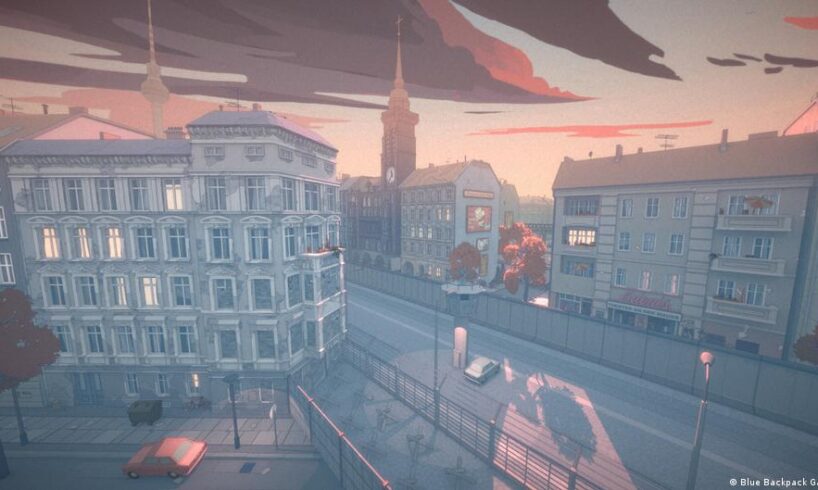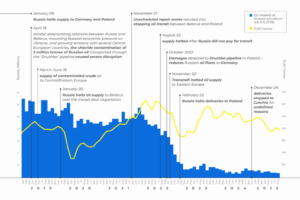
A novel new video game, “The Berlin Apartment” is initially set in 2020 when Germany was in lockdown due to the COVID-19 pandemic, and when few people walked the streets and cafes and restaurants were closed.
It begins with second-grader Dilara as she accompanies her father Malik to work since schools are closed.
Malik has been tasked with renovating an apartment in an old building in Berlin. As they begin to remove the wallpaper and tiles, they discover traces of the former residents.
Gamers can inhabit the unique perspective of these different Berliners as they embark on a four-hour journey through over a century of German history.
Malik uncovers layers of history that come alive as he renovates a Berlin apartmentImage: Blue Backpack Games
Exploring Germany’s dark past
The pivotal historical events explored in the game include the persecution and murder of Jews in Nazi Germany, the struggle for survival in postwar Germany, and state repression in the GDR. Throughout these eras, the atmosphere is gloomy.
One of the episodes, set in the winter of 1945, is the story of Mathilda, an apartment resident who misses her father — a decorated German soldier who hasn’t returned from World War II, which was started by Nazi Germany.
Mathilda, who lives with her brother and mother, starts decorating the Christmas tree with whatever she can find: Straw stars, medals, bullet casings found in the rubble of her bombed-out city. At their meagre Christmas dinner, she asks her mother: “Mum, are we the bad guys?”
Up until 1933, the Jewish cinema operator Josef had lived in the same apartment. But the Nazis burned down his cinema. Players get to follow Josef’s story as he prepares to flee to Paris.
While he’s packing, the suspense is gradually elevated by different sounds: A ticking clock, loud screams from the hallway, and aggressive knocking on the doors. At the same time, Josef’s apartment invites players on a journey through his eventful life, and into the world of cinema and the arts.
Fictional stories, factual history
The residents’ stories are fictional. “We made them up to make them entertaining, but they always take place against a historical backdrop,” explained Florian Köhne, managing director of the indie Berlin-based game studio, Blue Backpack, which created the game’s concept and design.
“We try to convey the story in such a way that you don’t need too much knowledge,” he added.
As they meticulously search the apartment, gamers find clues that gradually combine to form a broader first-person perspective. They also become immersed in the way that political systems restrict personal life and progress. Users learn to appreciate the privilege of living amid peace and freedom.
Ordinary people instead of heroes
“The Berlin Apartment” stories are not about heroes. The characters are simply trying to get by.
Many question the system, like the GDR writer composing a space novel with a strong woman protagonist. She has to rewrite the text over and over again due to regime censorship. She sits down at her typewriter and reluctantly complies with the wishes of the authorities so that she can be published.
The game deliberately refrains from making judgments about who is good or bad — or who supports the regime. It’s about experiencing life under different political systems, and often navigating restrictions on personal freedom. Do they flee, surrender to their fate, or simply try to make the best of it?
Gamers can explore how a female writer living in the apartment under East German rule is determined to be published, even in the face of censorshipImage: Blue Backpack Games
A fast-changing cityscape
The game’s art director, Hans Böhme, was inspired to create “The Berlin Apartment” when, standing at the window of his old apartment in Berlin, he wondered how many people had stood in exactly the same spot before.
The game includes a view from a window onto a street intersection that changes significantly over the decades. Street trams run under swastika banners in 1933. But in the postwar years, it’s a so-called death strip bordered by walls and fences that separate East and West Berlin.
The game’s residents, apartment and intersection are fictitious, yet are based on real-life models inspired by old Berlin apartments and museum materials. The narrative video game, “What Remains of Edith Finch” (2017), was also a touchstone as players can too delve deeply into a family’s history.
“The Berlin Apartment” belongs to the game genre was once disparagingly known as a “walking simulator,” whereby players merely find and collect items that help develop a narrative.
In doing so, they can easily empathize with residents and can ask: What would I have done? Which side would I have been on? Would I have submitted to the political system or would I have rebelled — and risked losing my livelihood, or even death?
“The Berlin Apartment” was released in November 2025 on all platforms and is available in German and English with subtitles in numerous languages.
This article was originally written in German.
A virtual tour of Germany’s inner border and the Berlin Wall
To view this video please enable JavaScript, and consider upgrading to a web browser that supports HTML5 video





